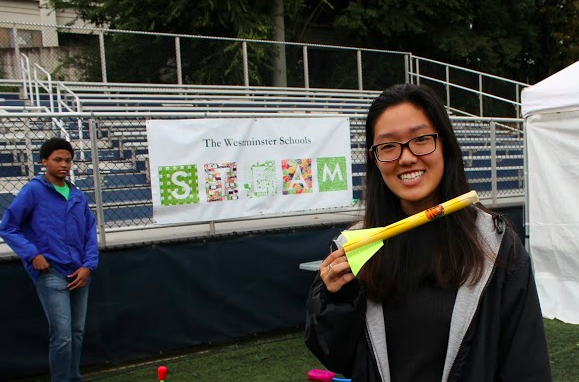Maker Faire provides STEAM opportunity

Senior Faith Cho at Westminster’s booth
A group of students from several different schools stood back to watch handmade rockets shoot into the air. This and many other experiments occurred at Atlanta Maker Faire, held on Oct. 3 and 4 in Decatur.
“Maker Faire is an event that happens worldwide,” said junior Omari Matthews, who attended Maker Faire. “It’s essentially for people who enjoy making things, tinkering, playing with electronics, designing stuff, and making them come to life.”
People of all ages are welcome to attend the fair for free, making it one of the most popular events within its category. The fair occurs worldwide.
The original Maker Faire occurred in San Mateo, California, in 2005, and has taken place annually ever since. This year, San Mateo’s Maker Faire hosted a record-breaking number of participants and attendees, with over 1,100 participants and over 145,000 attendees.
Maker Faire is supported by Make, one of the first magazines dedicated entirely to DIY (Do-It-Yourself) technology projects. Make magazine inspires and informs the growing community of inventive people who undertake projects and tasks in their basements, garages, or even their backyards. Make is produced by Make Media, a worldwide web platform with the purpose of connecting makers with each other .
In line with the DIY theme, JanTerm will feature a new course called “Making and DIY Culture.” Similar to Maker Faire, students participating in the JanTerm connect crafting to electronics through activities such as visiting a maker space, which is like a workshop.
Affiliated with Westminster for two years, the faire is a relatively new addition to the school’s STEAM (Science-Technology-Engineering-Art-Math) initiatives. This year, students built rockets out of paper and helped other students build rockets at their booth.
“We set up a station,” said sophomore Caroline Matton, “where we used little prototype rockets out of paper. We set up little machines, which we could jump on the end of and the rockets would shoot up.”
Students were encouraged to sign up.
“You sign up online to volunteer for a certain number of hours,” said Matton. “[During the fair,] you set things up, teach the kids, and explain to the adults about the programs and what STEAM is.”
STEAM is one of the newer initiatives within the school’s learning curriculum. Earlier this year, the Goizueta Foundation awarded $1.25 million as a grant in order to implement a wide-ranging initiative. Over the next three years, this grant will fund a new technological and explorative learning space, new resources for STEAM professional and curriculum development, and the creation of an endowment to sustain the initiative beyond the three years.
Increased student involvement in the coordination of the fair is also on the horizon.
“One of the ideas was that the Maker club can be the one to help make decisions,” said faculty advisor Mark LaBouchere, “making our presence within the fair student-led.”
